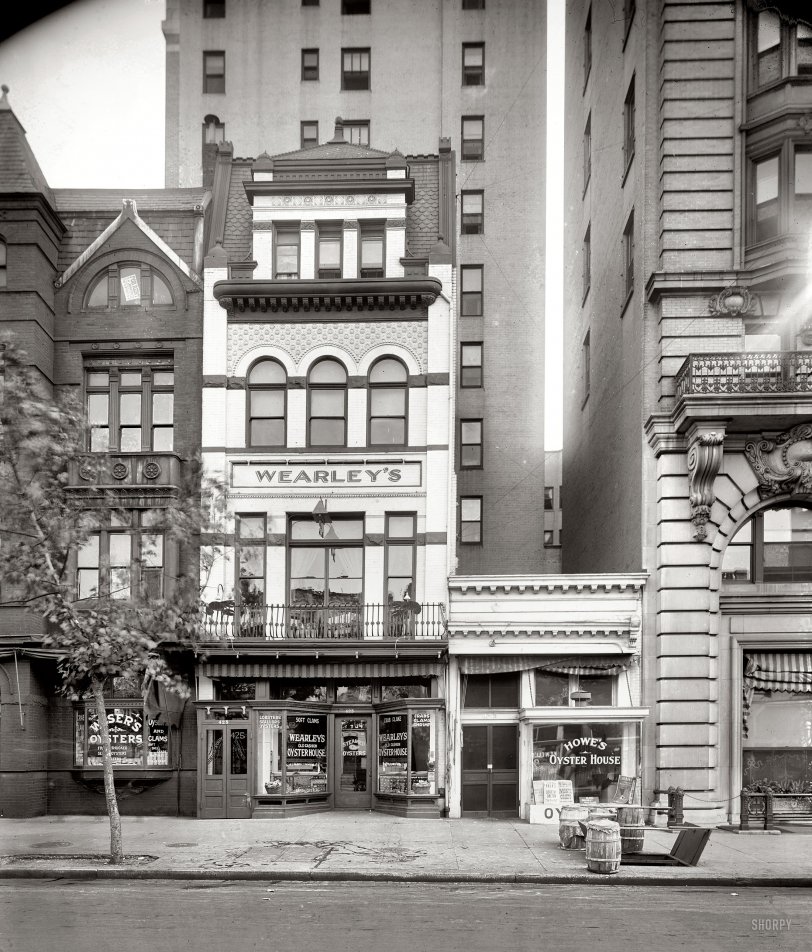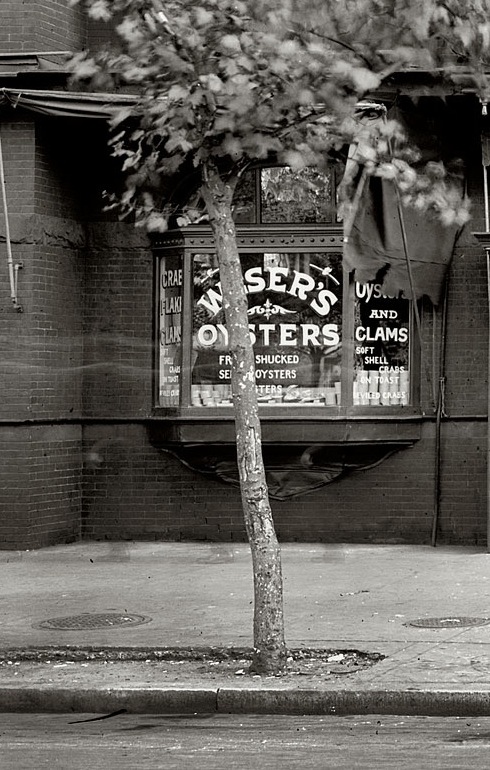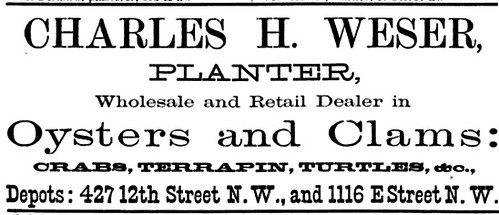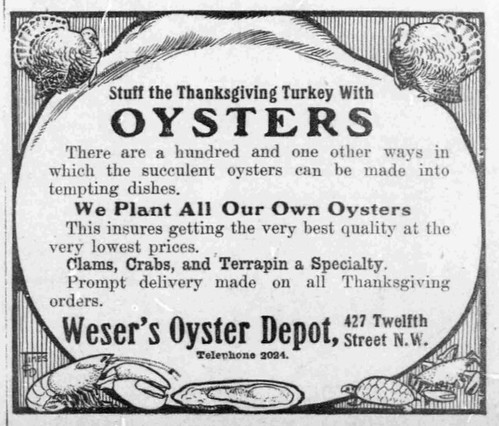


Framed or unframed, desk size to sofa size, printed by us in Arizona and Alabama since 2007. Explore now.
Shorpy is funded by you. Patreon contributors get an ad-free experience.
Learn more.

- Baldwin 62303
- Baldwin VO-1000
- Cold
- No expense spared
- Tough Guys
- Lost in Toyland
- And without gloves
- If I were a blindfolded time traveler
- Smoke Consumer Also Cooks
- Oh that stove!
- Possibly still there?
- What?!?
- $100 Reward
- Freeze Frame
- Texas Flyer wanted
- Just a Year Too Soon
- WWII -- Replacing men with women at the railroad crossing.
- Yes, Icing
- You kids drive me nuts!
- NOT An Easy Job
- I wonder
- Just add window boxes
- Icing Platform?
- Indiana Harbor Belt abides
- Freezing haze
- Corrections (for those who care)
- C&NW at Nelson
- Fallen Flags
- A dangerous job made worse
- Water Stop
Print Emporium
Oyster Alley: 1922

Washington, D.C., circa 1922. "Wearley's front." Exterior of the oyster bar seen in the previous post. This stretch of 12th Street N.W. seems to have been something of a seafood hot spot. At the right we see a sliver of the enormous Raleigh Hotel. National Photo Company Collection glass negative. View full size.
Weser descendants thank you
As descendants of Edward Weser and Joseph B. Weser, we thank you for this posting.
Oystercentrism
Much like today, blame New York for the trend. They became very popular there in the 19th century. Cheap from beginning to end, you could get them on most streets and they fed the working class. As immigrants poured in and the shift moved, they took their appetite with them and the oyster moved inland thanks to the burgeoning railroads that could deliver them.
Re: Why Oysters?
Anyone with the time and inclination to learn about oysters ought to read Mark Kurlansky's book The Big Oyster: History on the Half Shell. In part, the prevalence of oyster houses reflects the prevalence of the oyster itself. Europe's oyster beds had long been depleted from over-fishing and destruction of beds. In contrast, the waters of east coast (especially around New York Harbor) were bounteous. At one time, the fledgeling U.S.A. produced 88% of the world's oyster production. As a result oysters provided a cheap source of protein for people of all economic classes. In the 20th century, urban pollution (largely sewage and run-off) lowered the water quality and destroyed many of the oyster beds.
Incidentally, when this photo was made, my ancestors were dredging oysters in the Chesapeake - probably supplying oyster depots in both Baltimore and Washington.
UPDATE: Link to 2001 NYT article by Mark Kurlansky: "CITY LORE; When the Oyster Was Their World"
Soft Clams
I know what soft shell crabs are but what is a soft clam?
Why Oysters?
This may have been discussed before, but can anyone shed light on the appetite for oysters in America in the late 19th to early 20th centuries? I've seen pictures of small Midwestern and western towns with only a handful of businesses, and an "Oysters" sign among them. It seems folks couldn't go more than a day or two without eating an oyster.
[Fast-forward 100 years. Substitute "Starbucks" for "oysters." - Dave]
Gayety, Palace, and Metropolitan
The posters in front of Howe's advertise shows at three theaters that we've seen before on Shorpy:
Gayety: https://www.shorpy.com/node/6455
Palace: https://www.shorpy.com/node/5844 (in comments)
Metropolitan: https://www.shorpy.com/node/5539
Ornamental crustaceans
Gotta love those lobster decorations on the balcony railing above Wearley's.
The world would be my oyster
if I could rent that room on the top floor!
"Old Fashion"
Isn't it interesting and telling that "Old Fashion" could be used in 1922 to distinguish one establishment from two adjacent businesses that all seem to sell the same basic product.
Larry, Moe, & Curly (or was it Shemp?)
Might this be the place where the stooges had such trouble eating a simple bowl of soup?
Raleigh Hotel
A recent profile of the hotel here.
The difference
between an oyster depot and an oyster house is the baggage clam!
At a theatre near you!
Dorothy Dalton in The Siren's Call. Here's what she looked like. Has anyone ever seen it?

Weser's Oysters
The establishment to the left is Weser's Oyster Depot. Prior to Howe's, #423 was Hogan's Oyster Depot. Wearley's (established 1898 by Oscar B. Wearley) later moved to 418 12th. In 1950 another move to 516 N. Capitol Street, where it survived until the 1960s.
Does anyone know the distinction between an Oyster Depot and an Oyster House?
Washington Post, Feb 20, 1907Edward Weser Dies of Old Age.
Edward Weser, eighty-three years old, died yesterday morning at this home, 441 Seventh Street southwest. Death was caused by a complication of diseases due to old age. He was a native of Germany, but came to the United Sates when a boy. He was for several years a maker and seller of sulphur matches. In 1858 he established an oyster house at Twelfth and E streets, the management of which he continued until his death.
He is survived by his wife and three daughters, Mrs. Annie Gordon, Mrs. Barbara Swing, and Mrs. A.J. Comiskey, and two sons, C.H. Weser and Joseph B. Weser.



























On Shorpy:
Today’s Top 5